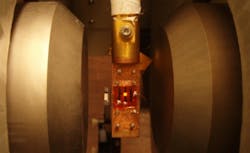Salt Lake City, UT--A new type of organic light-emitting diode (OLED) based on spintronics could be be brighter, cheaper, and more environmentally friendly than ordinary LEDs, say the scientists who invented it.
The group, from the University of Utah and the Technion-Israel Institute of Technology (Haifa, Israel), made a prototype of the new kind of LED—called a spin-polarized organic LED, or spin OLED—that produces an orange color. But they expect it will be possible within two years to use the new technology to produce red and blue as well, and he eventually expects to make white spin OLEDs.
“It’s a completely different technology,” says Z. Valy Vardeny, a professor at the University of utah and the senior author of a paper on the new OLEDs in the July 13, 2012 issue of Science. “These new organic LEDs can be brighter than regular organic LEDs.”
However, it could be five years before the new LEDs hit the market because right now they operate at temperatures no warmer than about -28 °F, and must be improved so they can run at room temperature, notes Vardeny. He developed the new OLED with Tho D. Nguyen, a research assistant professor of physics and first author of the study, and Eitan Ehrenfreund from the Technion-Israel Institute of Technology.
The new kind of OLED uses an organic semiconductor, as do ordinary OLEDs, but it isn’t simply an electronic device that stores information based on the electrical charges of electrons. Instead, it is a “spintronic” device, meaning information also is stored using the “spins” of the electrons.
Invention of the new spin OLED was made possible by another device—an “organic spin valve”—the invention of which Vardeny and colleagues reported in the journal Nature in 2004. The original spin-valve device could only regulate electrical current flow, but the researchers expected they eventually could modify it to also emit light, making the new organic spin valve into a spin OLED.
In the new study, the physicists report two crucial advances in the materials used to create “bipolar” organic spin valves that allow the new spin OLED to generate light, rather than just regulate electrical current. The first was the use deuterium instead of normal hydrogen in the organic layer of the spin valve, which made the production of light by the new spin OLED more efficient. The second was the use of an extremely thin layer of lithium fluoride deposited on the cobalt electrode. This layer allows negatively charged electrons to be injected through one side of the spin valve at the same time as positively charged electron holes are injected through the opposite side.
It is the ability to inject electrons and holes at the same time that allows light to be generated. When an electron combines with a hole, the two form an exciton and the energy is released in the form of light. Existing OLEDs each produce a particular color of light – such as red, green and blue – based on the semiconductor used. Vardeny says the beauty of the new spin OLEDs is that, in the future, a single device may produce different colors when controlled by changes in magnetic field.

John Wallace | Senior Technical Editor (1998-2022)
John Wallace was with Laser Focus World for nearly 25 years, retiring in late June 2022. He obtained a bachelor's degree in mechanical engineering and physics at Rutgers University and a master's in optical engineering at the University of Rochester. Before becoming an editor, John worked as an engineer at RCA, Exxon, Eastman Kodak, and GCA Corporation.
